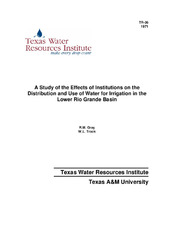| dc.description.abstract | Water users in the Lower Rio Grande Basin of Texas have depended on the flow of the Rio Grande to supply water for agricultural as well as municipal and industrial purposes. Although the area is a major agricultural production region, it faces continuing problems associated with use of irrigation water from the Rio Grande. Periodic water shortages threaten to limit the potential growth and economic well-being of the area. Inefficient use of available water supplies as a result of inadequate and/or antiquated distribution facilities and inefficient management of water on farms contributes to the depletion of available water supplies for irrigation and other uses.
The objectives of this study were: (1) to study the effects of water rights as allocative devices for water; to determine the impact on cropping patterns and water use efficiency of a change which would make rights negotiable, and (2) to study the influence of Water Control and Improvement Districts on the distribution and use of water; to determine whether the ways in which these districts are organized and operated may cause them to act as facilitating or obstructing elements in the efficient development and use of water resources in the Valley.
To meet the first objective, parametric linear programming was used to analyze the impact of negotiable water rights on cropping patterns and enterprise combinations. If the institution of water rights were changed so as to make annual allotments negotiable, market forces could be expected to move the resource into uses in which it has a higher value. Water price was varied from $9.60 per acre foot to $96.00 per acre foot. At a price of $9.60, which is approximately the present cost of irrigation water delivered at the farm gate, producers could profitably use almost 2,000,000 acre feet of water per year. At this price, 83 percent of the irrigable lands and 77 percent of the water used in the Valley would be devoted to the production of cotton and grain sorghum. At a water price of $18.65 per acre foot or higher, grain sorghum production in the Valley reverts dryland and water use for irrigation drops to 1,363,300 acre feet per year. At a price of $32.45 or above, the land devoted to cotton would be switched to dryland grain sorghum production and water use would decline to 407,900 acre feet annually.
The use of parametric programming with variable water pricing allowed the derivation of a value-in-use or "conditional demand" curve for water.
To meet the second objective of the study, data on the Valley Water Control and Improvement Districts were analyzed using multiple regression analysis. The dependent variable was delivery cost per acre irrigated. Size of district, acre feet pumped per acre irrigated, and percent of operating revenues derived from water deliveries were the independent variables. It was found that the optimum size district, from a least-cost standpoint, was 42,355 acres. However, other institutional problems associated with District policy and organization would seem to more than offset cost advantages of reorganization and consolidation. Therefore, it does not seem likely that local water users would seek changes in the organizational structure of districts simply to take advantage of economies of size associated with consolidation. iii Rehabilitation of district facilities was analyzed using data from the parametric programming model for five levels of development. It was found that rehabilitation of district facilities is economically feasible, at least to the present level of water use in the Valley. | en |


